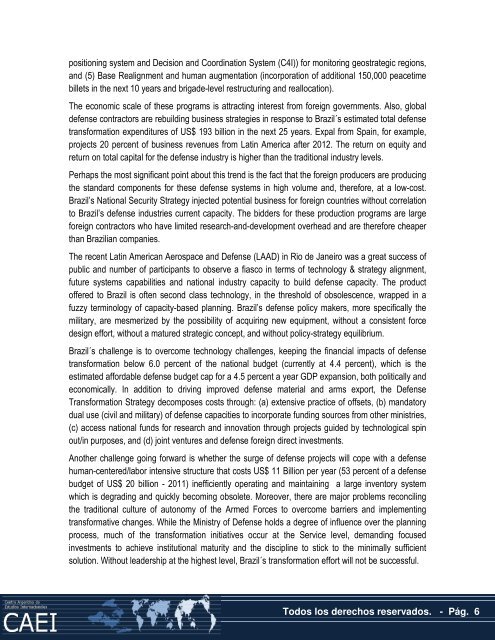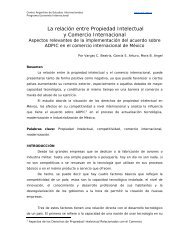Brazil's Defense Industry: The Emerging Transformational ... - CAEI
Brazil's Defense Industry: The Emerging Transformational ... - CAEI
Brazil's Defense Industry: The Emerging Transformational ... - CAEI
You also want an ePaper? Increase the reach of your titles
YUMPU automatically turns print PDFs into web optimized ePapers that Google loves.
positioning system and Decision and Coordination System (C4I)) for monitoring geostrategic regions,<br />
and (5) Base Realignment and human augmentation (incorporation of additional 150,000 peacetime<br />
billets in the next 10 years and brigade-level restructuring and reallocation).<br />
<strong>The</strong> economic scale of these programs is attracting interest from foreign governments. Also, global<br />
defense contractors are rebuilding business strategies in response to Brazil´s estimated total defense<br />
transformation expenditures of US$ 193 billion in the next 25 years. Expal from Spain, for example,<br />
projects 20 percent of business revenues from Latin America after 2012. <strong>The</strong> return on equity and<br />
return on total capital for the defense industry is higher than the traditional industry levels.<br />
Perhaps the most significant point about this trend is the fact that the foreign producers are producing<br />
the standard components for these defense systems in high volume and, therefore, at a low-cost.<br />
Brazil’s National Security Strategy injected potential business for foreign countries without correlation<br />
to Brazil’s defense industries current capacity. <strong>The</strong> bidders for these production programs are large<br />
foreign contractors who have limited research-and-development overhead and are therefore cheaper<br />
than Brazilian companies.<br />
<strong>The</strong> recent Latin American Aerospace and <strong>Defense</strong> (LAAD) in Rio de Janeiro was a great success of<br />
public and number of participants to observe a fiasco in terms of technology & strategy alignment,<br />
future systems capabilities and national industry capacity to build defense capacity. <strong>The</strong> product<br />
offered to Brazil is often second class technology, in the threshold of obsolescence, wrapped in a<br />
fuzzy terminology of capacity-based planning. Brazil’s defense policy makers, more specifically the<br />
military, are mesmerized by the possibility of acquiring new equipment, without a consistent force<br />
design effort, without a matured strategic concept, and without policy-strategy equilibrium.<br />
Brazil´s challenge is to overcome technology challenges, keeping the financial impacts of defense<br />
transformation below 6.0 percent of the national budget (currently at 4.4 percent), which is the<br />
estimated affordable defense budget cap for a 4.5 percent a year GDP expansion, both politically and<br />
economically. In addition to driving improved defense material and arms export, the <strong>Defense</strong><br />
Transformation Strategy decomposes costs through: (a) extensive practice of offsets, (b) mandatory<br />
dual use (civil and military) of defense capacities to incorporate funding sources from other ministries,<br />
(c) access national funds for research and innovation through projects guided by technological spin<br />
out/in purposes, and (d) joint ventures and defense foreign direct investments.<br />
Another challenge going forward is whether the surge of defense projects will cope with a defense<br />
human-centered/labor intensive structure that costs US$ 11 Billion per year (53 percent of a defense<br />
budget of US$ 20 billion - 2011) inefficiently operating and maintaining a large inventory system<br />
which is degrading and quickly becoming obsolete. Moreover, there are major problems reconciling<br />
the traditional culture of autonomy of the Armed Forces to overcome barriers and implementing<br />
transformative changes. While the Ministry of <strong>Defense</strong> holds a degree of influence over the planning<br />
process, much of the transformation initiatives occur at the Service level, demanding focused<br />
investments to achieve institutional maturity and the discipline to stick to the minimally sufficient<br />
solution. Without leadership at the highest level, Brazil´s transformation effort will not be successful.<br />
6<br />
Todos los derechos reservados. - Pág. 6

















